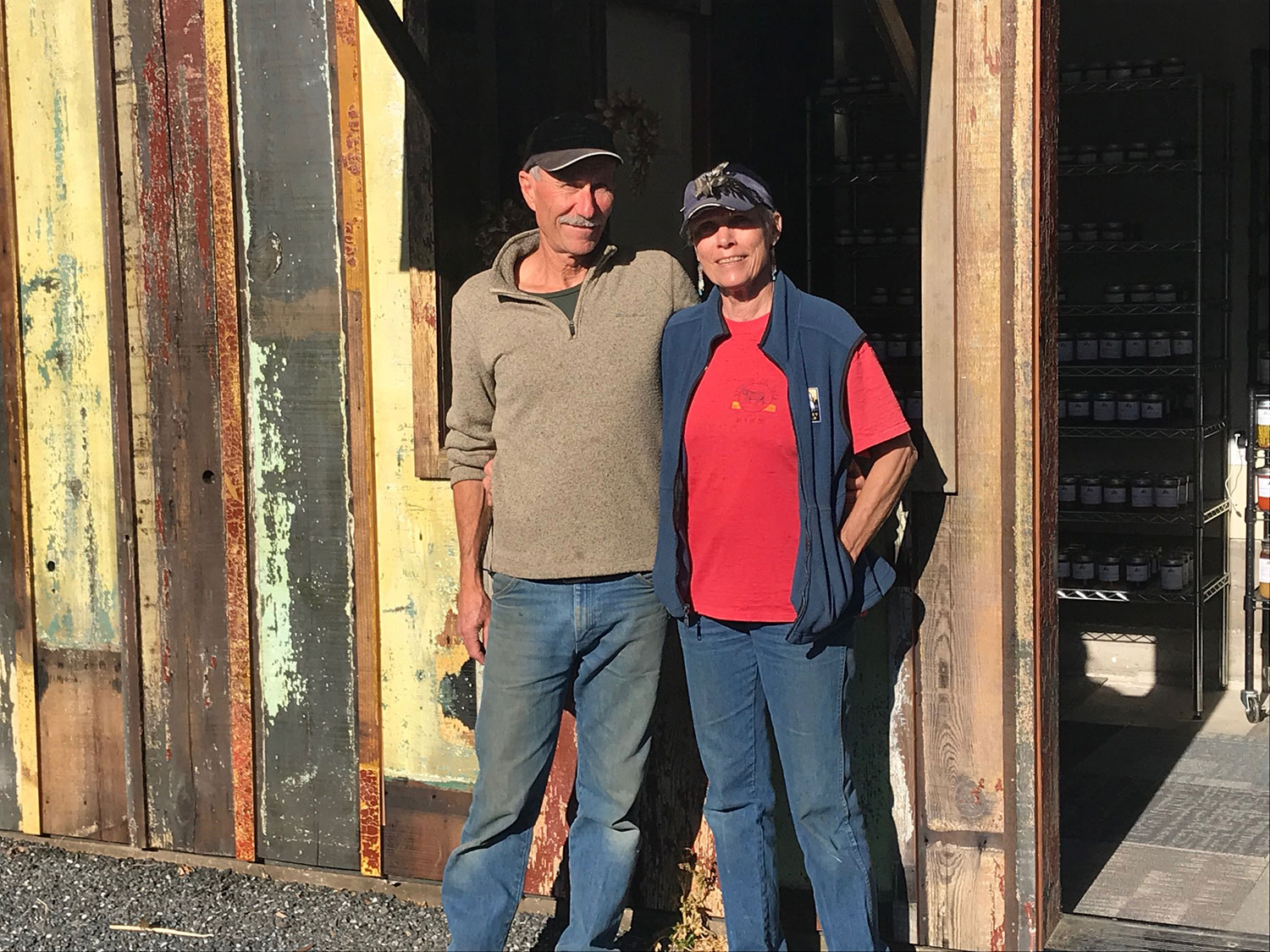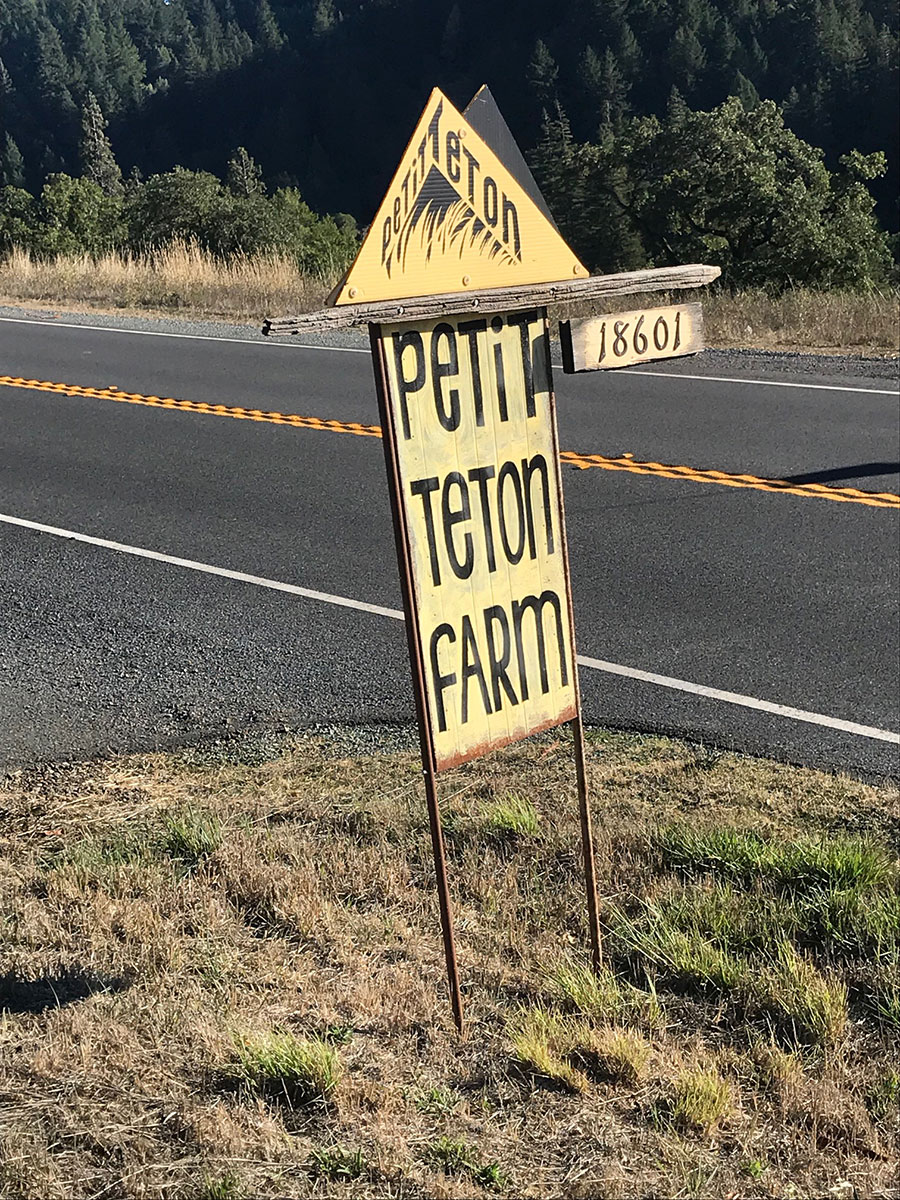Petit Teton

A Permaculture Farm Built from the Ground Up
by Rachel Turner Williams
Wending my way up the steep paved drive, lined by an old split rail fence, several welcoming, hand-painted signs, and an iconic blue 1951 Chevy pick-up, it is hard to fathom that Petit Teton Farm has not stood here for generations. Pulling up to the parking area, I notice another hand-painted sign suggesting to “bong the gong,” or “look for us in the field,” and it is immediately clear to me that this is a working farm. No bells or whistles or fancy shop to be found here. Rather, I am greeted by chickens and two friendly dogs while I take in the sheer beauty of my surroundings. A wall of distant redwoods outside of the property blends into rolling hills, including a tall, pointy one that inspired the name of the farm. Countless varieties of well-established trees and shrubs intermingle with row upon row of diverse crops. Far in the distance, I can make out the form of a yak, a rare sight for northern California. A beautiful structure, made of varnished old barn wood, houses hundreds of jars of homemade preserves in a slew of colors, all glistening like gems in the afternoon light.
While taking this all in, I am greeted by Nikki Ausschnitt and Steve Krieg, who are both in the midst of completing various farm tasks. They quickly let me know that when they first found the place in 2004, it was an old sheep ranch, and, with the exception of their simple concrete block house and a few other structures, “none of this existed.” Not much had been grown or maintained on the 375 acres that now make up their farm. I find that hard to believe as I accompany them in feeding their animals and taking a tour of the thriving landscape. I am blown away by the diversity of what they produce—peppers, greens, artichokes, quinces, grapes, figs, hazelnuts, blackberries, asparagus, capers, cacti, jujubes, and golden berries—to name just some. This flourishing utopia reflects Steve and Nikki’s passion for permaculture, a fascination that influenced their decision to leave San Francisco years ago and begin a new life. Rather than limiting themselves to a handful of lucrative crops, they have enjoyed experimenting and “going with what grows or is natural” for the living ecosystem they have created.
A growing interest in permaculture was not the only factor that inspired Nikki and Steve’s move and major lifestyle change. He is a lawyer and she is an artist, and they were looking for something new that they could put their time, money and energy into, something that was not co-opted by big money. For them, it was largely about “finding what’s real” and committing themselves to it fully. Farming and living off the land made sense for them. It was tangible. They loved dirt and their small backyard in the city. As an artist, Nikki sees the land as an extension of her art. For her, the old, austere sheep ranch provided a perfect blank canvas to sink her creativity into. They were drawn to Anderson Valley, specifically, because they “wanted wild,” and they were struck by the pure visual of it, by its raw beauty.
Being that neither of them had a background in farming, part of the original vision of Petit Teton included attracting young farmers who were not able to buy their own land. By working alongside them, Nikki and Steve hoped to learn all about farming themselves. This is how they came to meet and work with Jessie Spain, a young woman who grew up in the area, who had been awarded a scholarship for an agroecology course in Santa Cruz. Jessie was extremely knowledgeable in farming and taught Steve and Nikki all about running the farm. Through her guidance and some of their own research, trial and error, they began growing and selling produce for markets and CSAs, grafting trees, and raising animals for meat and eggs.
Over time, Nikki’s sons both became an active part of the farm. One of them farms and lives there full-time with his young family. The other goes back and forth between the farm and San Francisco, where he sells their goods at the Clement Street market each week. Over the years, they have also welcomed a few other long-term employees who have become a part of their farm family, one of whom also resides on the property in a house they built for him. Given the complexity of what they produce and the ever-evolving ecosystem of Petit Teton, it was important to Nikki and Steve to find people who were interested in staying and getting to know and invest themselves in the farm and the land for the long-term. As such, they have created less of a typical workplace environment and much more a familial working community.
In addition to the produce, meat and eggs they sell at markets and on the farm, Petit Teton has perhaps become best known for its plentiful and creative assortment of canned preserves. When asked how this came about, Steve and Nikki make it clear that their foray into value added products was not an original part of their plan, per se. Rather, it stemmed from their concern for the wasteful ways of our society, a concern that already had them picking up slops weekly around town that they could use on the farm. When they found that they were producing more than they could sell fresh at the markets, it was only natural for them to want to find a way to use everything they grow. This desire, along with their resourceful and artistic natures, has led to a wonderful sundry of jams, sauces, drink mixes and more, all made exclusively with a unique assortment of ingredients that are produced on site. As Nikki and Steve like to say, “We grow what we can, and then we can it!”
Walking into their on-site commercial kitchen, which has become the heart of the farm, is a feast for the senses. Various colorful canned goods, nuts, and gift packages catch my eye as we walk over to a massive prep table taking up much of the kitchen. The garlic, dill, and other herbs that Nikki busily starts prepping begin to permeate the air as the three of us continue our conversation. The large, functional kitchen is hospitable and surprisingly low-tech given the volume of goods that flow through it. An assortment of knives and large pots appear to make up the bulk of their utensils. No question here as to what “handmade” means to them.
Our conversation shifts to what their day-to-day looks like, and to what being a farmer means to them. I am struck by the way they both light up when asked about their lifestyle. Of course, it is a lot of hard work, and it is certainly not something everyone is cut out for, but they cannot imagine doing anything else, and the joy they get from it shows on both their faces. They have no desire to spend these years of their lives traveling around on cruise ships or taking it easy on a beach somewhere. They both have a need to stay busy with their creative endeavors, and, moreover, a desire to someday be able to pass these endeavors on.
Steve talks about the great mix that farming entails—everything from the daily physical labor and paperwork, to having to become skilled as a “vet” in an emergency situation. They both enjoy the excitement and the unknown that comes in their day-to-day lives. Though they wake each morning with a list of what they think their day will look like, they never actually know what unexpected turn will come their way. “That makes it fun, though it requires the need to be flexible in dealing with whatever comes along.” They likewise never know who is going to show up and “bong the gong,” giving way to what Nikki refers to as their “accidental social life,” to which there is a real sense of adventure.
Being a farmer requires wearing a lot of hats, something both Steve and Nikki are happy to do. Not only does it feed their creativity and their love of experimenting, but it keeps them active, both physically and mentally. Their bodies and minds are constantly going. “No need for Sudoku here,” they joke, adding that they treasure their well-earned evening soaks in the hot tub. As we come toward the end of our visit, Nikki talks about how people do not have a choice about where or what they are born into, but that she believes life is about learning who you are and where you want to be. It is clear that both she and Steve have discovered exactly what this is for them, and that is something they honor each day.
As I start my descent back down the steep road, I cannot help but think of all Nikki and Steve have created in their quest to find what is real. With their hands, they have made much food, art, and entire ecosystems. They have made a business, a home, and a thriving farm family. I think about their desire to pass something on as I drive by the enormous cedar that was once their small potted Christmas tree in San Francisco, and I feel certain they will have much to pass on.
Petit Teton 18601 Hwy 128, Yorkville, CA 95494 | (707) 684-4146 farmer@petitteton.com | PetitTeton.com Visit Petit Teton at the farm, year-round at the Clement St. Market in San Francisco, and at the Mendocino Farmers Market during the summer.
Rachel Turner Williams lives in Boonville, where she is active with the Foodshed and the Land Trust. She is currently training in integrative nutrition and enjoys growing, cooking, writing, and gathering around food. Landscape and yak photos courtesy




